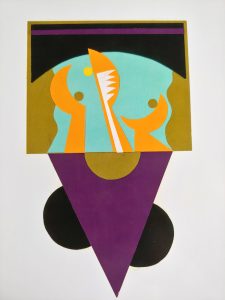Stations of the Resurrection
II – Witnesses at the Empty Tomb
A Psalm Paraphrase
Lection
1 Corinthians 15:35–44
35But someone will ask, “How are the dead raised? With what kind of body do they come?” 36You foolish person! What you sow does not come to life unless it dies. 37And what you sow is not the body that is to be, but a bare kernel, perhaps of wheat or of some other grain. 38But God gives it a body as he has chosen, and to each kind of seed its own body. 39For not all flesh is the same, but there is one kind for humans, another for animals, another for birds, and another for fish. 40There are heavenly bodies and earthly bodies, but the glory of the heavenly is of one kind, and the glory of the earthly is of another. 41There is one glory of the sun, and another glory of the moon, and another glory of the stars; for star differs from star in glory.
42So is it with the resurrection of the dead. What is sown is perishable; what is raised is imperishable. 43It is sown in dishonor; it is raised in glory. It is sown in weakness; it is raised in power. 44It is sown a natural body; it is raised a spiritual body. If there is a natural body, there is also a spiritual body.
P: This is the word of the Lord.
C: Thanks be to God.
John 20:1–9
1Now on the first day of the week Mary Magdalene came to the tomb early, while it was still dark, and saw that the stone had been taken away from the tomb. 2So she ran and went to Simon Peter and the other disciple, the one whom Jesus loved, and said to them, “They have taken the Lord out of the tomb, and we do not know where they have laid him.” 3So Peter went out with the other disciple, and they were going toward the tomb. 4Both of them were running together, but the other disciple outran Peter and reached the tomb first. 5And stooping to look in, he saw the linen cloths lying there, but he did not go in. 6Then Simon Peter came, following him, and went into the tomb. He saw the linen cloths lying there, 7and the face cloth, which had been on Jesus’ head, not lying with the linen cloths but folded up in a place by itself. 8Then the other disciple, who had reached the tomb first, also went in, and he saw and believed; 9for as yet they did not understand the Scripture, that he must rise from the dead.
P: This is the word of the Lord.
C: Thanks be to God.
Artwork and Discussion
Matthew 28:5-10 — Mark 16:1-8 — Luke 24:1-12 — John 20:1-9
All that the incredulous disciples of Jesus, both male and female, can do is verify that the tomb is empty. Their understandable fear is addressed by the messengers in the vacated tomb. “Do not be afraid” is an imperative that echoes throughout the gospel accounts of the life of Christ. This was definitely not what they expected nor dared to hope. So to reorder their minds and hearts, they are admonished to remember what Jesus had told them earlier when they were together in the region of Galilee: “The Son of Man must be delivered into the hands of sinful men, be crucified, and on the third day be raised again!”
Verification depends on two or three witnesses, so the accounts tell us of both divine and human verdicts established by “two men in lightning bright clothes” who confront “Mary Magdalene, Joanna, Mary the mother of James and others” with the new reality (Luke). On their hurried exit from the tomb precincts, Jesus actually meets “Mary Magdalene and the other Mary” and gives them a message for the male disciples: “Go and tell my brothers to go back to Galilee; there they will see me” (Matthew). Galilee is the place of ministry; there the ministry of Jesus will be transferred to his disciples. Matthew follows the text of Mark, who names “Mary Magdalene, Mary the mother of James, and Salome” as the witnesses at the tomb. While women were not generally allowed as witnesses in court in those days all the gospel narratives agree that these named women were the first witnesses (preachers) of the empty tomb, even though they didn’t yet understand its meaning. The male disciples “did not believe the women because their words seemed to them as nonsense” (Luke 24:11). But Peter had to check it out.
John’s account has Mary Magdalene discovering the uncovered entrance to the grave cave, the stone door having been pushed aside. She jumps to the conclusion that grave robbers have been at work and runs to get Peter and John who have a foot race to the tomb. Peter actually crawls inside the tomb and discovers burial cloths neatly wrapped; John then also enters the tomb–“he saw and believed”–probably coming to the conclusion that if the grave robbers had been at work, they wouldn’t have unwrapped the corpse and left the linen cloths behind.
God will have the last word when it comes to death and life, tomb and resurrection. If our idea of God is large enough, the improbability of resurrection is no problem, even though death remains our “last enemy.” Before Jesus can offer us a life like his, he joins us in a death like ours.
Meditation / A Responsive Reading
The Prayer
